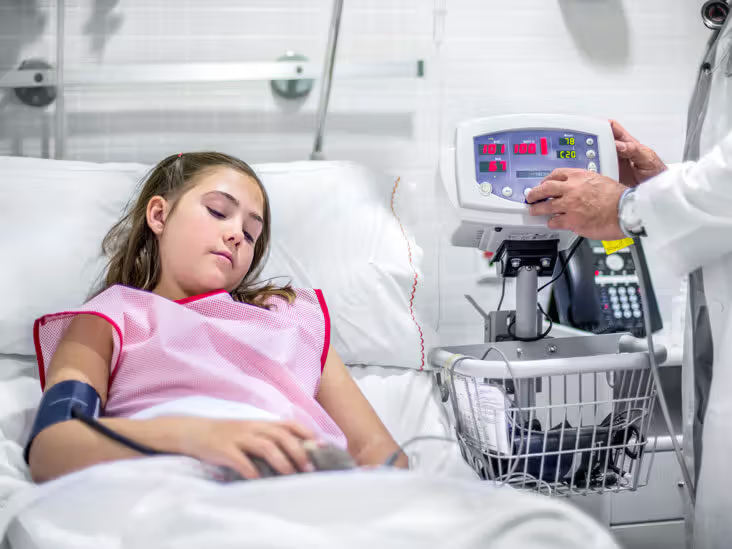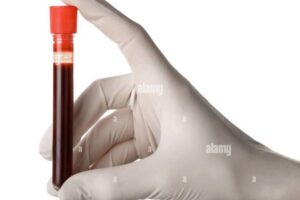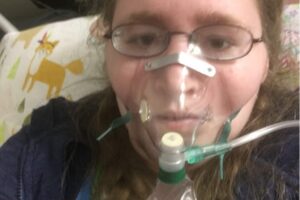Table of Contents
High Blood Pressure, My Low Potassium, and Hospitals
Following Dr. Green’s advice; I had been to the ER multiple times in the three-month gap between my second and third appointments. She had instructed us to go there every time the top number (systolic) of my blood pressure went over 200, or my bottom number (diastolic) went over 110. The thing was every time I was at the ER they would order blood work and my low potassium would force them to admit me to the hospital at least overnight to get me replenished.

Going into V-Tach Because of My Low Potassium
Because my low potassium would be critically low and because it wouldn’t respond to oral potassium, they would usually have to admit me.
I would either go to the ICU, critical care step-down unit, or a telemetry unit. That’s because potassium affects the heart and can be deadly if not immediately treated. It can cause fatal heart rhythms and even cause the heart to completely stop.
Low potassium can be very serious if not properly addressed. It can cause fatal arrhythmias. A couple of times they caught me going into v-tach . I would feel like there were butterflies in my throat trying to rise up and the heart monitor would start going off like crazy. Then there would be the sounds of running footsteps and people racing into my room pulling a crash cart behind them. My heart rate always returned to normal before anything too bad happened, but it sure caused a panic. Just goes to show you how scary my low potassium can be. I was lucky it didn’t kill me.

Being a Medical Mystery
At my three-month follow-up with Dr. Green, I once again had her stumped. The 24-hour urine test for porphyria had come back normal and the amount of catecholamines in the urine was normal. She had prescribed me 100 mcg of levothyroxine after a blood test showed that my thyroid was hypoactive. Now my thyroid levels were normal as well. On all ultrasounds and labs, my kidneys appeared healthy, however, I was so far from healthy I couldn’t even brush healthy with my fingertips if I stretched out my arms.

What bothered me the most about this whole medical mystery was the weight gain. I never changed how I ate yet I doubled my weight and developed my low potassium. At least at today’s appointment with Dr. Green, I hadn’t gained any more weight. The problem was my weight was sitting smack dab at 180 pounds and I was only 4’10. If the problem had been from overreating than I wouldn’t have any issues with my low potassium becuase I’d be getting plenty of different electrolytes and minerals from what I was consuming, part of my proof that the weight gain made no sense was my low potassium.
The other problem was that my blood sugar was spiked high as can be, sometimes my glucometer was spitting out numbers like 450, or 379. My A1C, a measure of your blood sugar over three months, slowly crept up.

Trying Glipizide to Control My Diabetes
“I don’t like the trend of your blood sugars,” Dr. Gordon my endocrinologist told me after I tested at least over 250 four times a day, every day for two weeks. I traced a heart with a finger tip on the exam room paper and looked around at all the posters about healthy eating on the wall.
This was so unfair. I barely ate, and when I did, it was usually a single bottle of nutritional supplement. How did I end up with my high blood pressure? Where did these crazy high blood sugars come from? How did I end up with my low potassium?
“I’d like to start you on another oral diabetes medication before we try insulin. Are you okay with that?” she asked me.
“I am definitely okay with that, less needles = happier Becca. I smiled at her.
“Great, so we’ll try the Glipizide then,” She smiled at me. “I will start you off at 10 mg, you should take it thirty minutes before breakfast every morning.”

I Am Not Overeating
“You mean before my morning Glucerna?” I asked.
“Yes, that, and whatever else you eat for breakfast.” She said.
“I don’t eat anything else for breakfast,” I told her. “I barely have more than that at lunch and dinner, and I don’t do snacks.”
“It’s okay, a lot of my patients have trouble realizing how much they are over-eating. A lightning bolt of anger slashed through me. Of course, she didn’t believe me. No one ever believed me, plus all the whacky health problems that happened to me that were so rare no one could figure out what was wrong with me. It was getting to be the theme of my life if my life were a book.

Dealing with Hypoglycemia on Top of My Low Potassium
I didn’t say anything else to Dr. Gordon who was sending my new medication, the Glipizide to the pharmacy. Once she sent the perscription I silently walked out of the exam room and went to the receptionist to make a follow-up.
The Glipizide was a small white pill. The problem with it was that if I didn’t drink enough Glucerna every day, my blood sugar would drop so low that I would get all shaky and pale and clammy. Sometimes it dropped my blood sugar so low that I passed out and my mom would have to put glucose gel in my mouth and wait for me to wake up. I had to check my blood sugar every four hours during the day, and once overnight. If I forgot, my mom reminded me.
Because my health was so fragile, I couldn’t really go anywhere on my own that summer. I had to stick by my mom so that she could help take care of me. My life as a college student was on hold, my life as an invalid was turned on full blast.

Going to the Infusion Center for Iron and Potassium
On top of everything else, once a month I had to go to the infusion area of the Kidney Center, get an IV placed, and then get a back of reddish-brown, dark, bloody looking iron.
I also usually received potassium, because, chances were, my low potassium was approaching critical low and we had to catch it before it turned deadly. Other times they gave me magnesium or sodium phosphate either instead or as well. Sometimes I spent all day at the clinic, sitting in a green recliner chair with my feet up, just like all the other green armchairs with IV poles next to them encircling the room in 2/3s of a circle. I would read a book, write on my laptop, cuddle a stuffed animal, or chitchat with the nurse, Phil, who was a trip.

Losing IV Access Due to Overuse
The more times they poked me for IVs, the harder a time Phil had in getting IV access in me. There were days when they would have to send me to the hospital to get my infusion because no matter how hard he tried Phil couldn’t get a line in. He even had some of his other nurses try and I was just turning into a human pincushion.
“Here’s the deal,” Phil told me. “Your potassium is 2.6, that’s critically low. You need to be repleted, but your veins are so used up that we have all gone through all our bags of tricks. We have no other choice than to send you to the hospital where they have things like ultrasound-guided IV lines and the ability to place PICC lines and ports,” he added under his breath, but I heard him, and I knew that’s what I needed.
At the ER they tilted the whole stretcher so that my feet were higher than my head. Then they put ultrasound goo on my neck to ultrasound the veins and find a juicy one in my neck. Still, I was too dehydrated and scarred over. Other times, when they were trying to put EJ lines in me, the doctors would tell me to do really weird things like sticking my thumb in my mouth and blowing on it really hard to get the vein to pop out. Doing so made me feel ridiculous.

Do I Need a Port-a-Cath or Other Central Line Access?
Each time they tried to put any sort of line in me, it got even harder. That’s when all the doctors and nurses in the ER starting bringing up the idea of getting a port or PICC line or tunneled line placed.
“It’s too dangerous for you not to have one,” said Dr. Koen, one of my favorite ER doctors. “You come in really sick, a lot, and if we can’t get IV access on you immediately it puts a major delay on treatment. A delay that could cost you your life. You need to start talking to your outpatient team about getting a central line placed ASAP, before something tragic happens.”
“What would you think about some sort of central line access so that I can get emergency treatment faster in an emergency and don’t need to be poked a million times just for one blood test?” I asked Dr. Green hopefully. Thinking of my last blood test where we resorted to pricking mmy finger with a lancet and then milking the blood out into a tiny little test tube because there was absolutely no other way to get blood out of me. It was like my arms and hands were rocks and had no veins in them.

No Central Line for Me Yet
“You have no immune system. Central lines are a breeding ground for bacteria. If you get a central line you could get a bloodstream infection that would make you so sick it could kill you. They are nothing to play around with, I’d like to stick with the peripheral lines as long as we possibly can. If we absolutely need to; in the next year or so I’ll have you get a port-a-cath,” Dr. Green decided about central line access.
I was left feeling dejected and frustrated. If I had to pick between being a constant pincushion or possibly getting a really bad infection, I would choose the latter. Of course, I’d never been through severe sepsis at that point either. Even though I argued my case, Dr. Green stood firm. Then she changed the subject.
A 24 Hour Urine Cortisol Test
“The only test I can think of left to do is 24-hour urine cortisol. I can’t imagine it will tell us much just because when we drew your blood at 8 AM to get an AM Cortisol, it was normal, but you have a moon face, high blood pressure, rapid weight gain, and rapid heart rate. Those are all symptoms of too much cortisol.”

Dr. Green sent me home with a collection hat, a 3 L orange jug, and labels in hand. I had to wake up, pee, and write down the time on the top of the orange jug, then flush the pee. The next time I had to pee, I had to pee in the collection hat, then I had to pour the pee into the orange jug, seal it, and put it in the fridge.
For the next twenty-four hours every time I had to pee, I had to pee in the collection hat and dump it into that jug then put it back in the fridge. The following morning at the exact time it said on the top of the jug, I peed one last time into the collection hat Then I filled out the label, stuck it on the jug and put it in the biohazard bag Dr. Green had given me. My mom and I drove it down to the lab.
After we dropped it off, I didn’t think much more about it. My hopes that the 24-hour urine would turn out some magical answer to my mystery disease were not very high at all.

I’m Being Smothered By a Medical Mystery
A heavy depression settled over me like a cloud of smog. My whole life revolved around medical issues and procedures and testing. I tried to distract myself with my pre-nursing requisites and the novel I was writing, but pretty much every other waking, and even sleeping moment of my life revolved around my health. There were testing, doctor’s appointments, and emergency room visits for my low potassium, my high heart rate, my high blood pressure, passing out, abnormal heart rhythms, and fluid in my lungs. The worst part was that we didn’t know what was causing all of this to happen.
Discover more from chronicallyalive.org
Subscribe to get the latest posts sent to your email.




